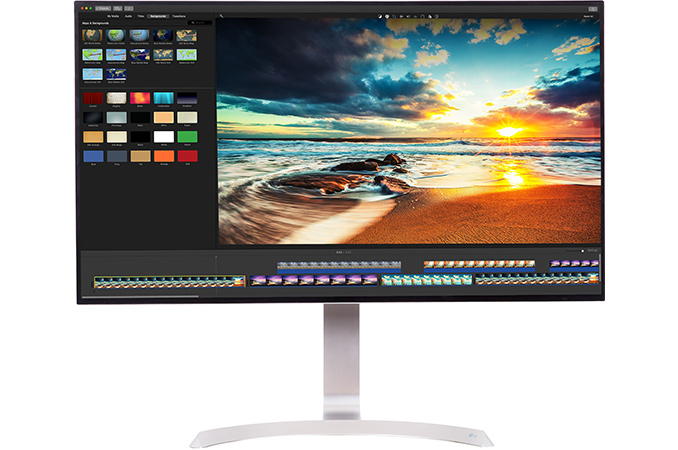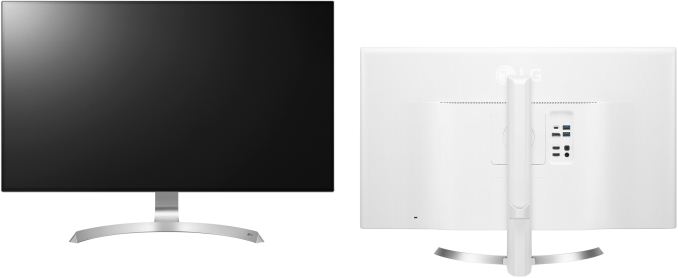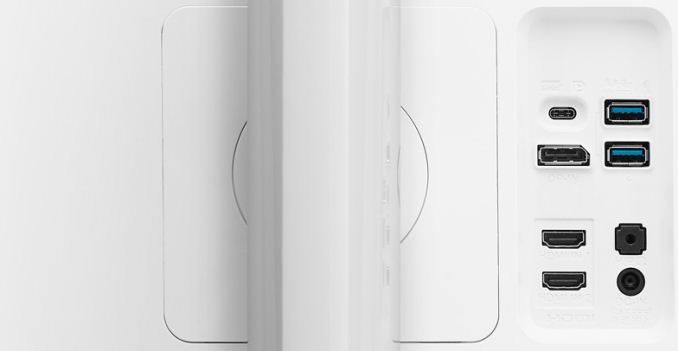Pre-Orders for LG’s 32UD99 Display Available: 4K, DCI-P3, HDR10, FreeSync for $999
by Anton Shilov on April 10, 2017 4:00 PM EST
LG and its partners recently disclosed the complete specifications as well as the price of the LG 32UD99 flagship consumer display. The 32-inch display will feature a 4K (UHD) resolution, support for HDR10, a 95% DCI-P3 color gamut, and support for AMD’s FreeSync that the manufacturer announced in December. Multiple retailers in the U.S. are now taking orders on the monitor with ETA in April or May. The price of the display is in line with other high-end consumer products, clearly emphasizing its positioning for enthusiasts and prosumers.
As reported, the LG 32UD99 is based on an IPS panel with a native 3840×2160 resolution that can reproduce 1.07 billion colors and cover over 95% of the DCI-P3 color space as well as 100% of the sRGB color gamut. The display supports HDR10 capabilities (LG does not disclose information about 3D LUT (look-up tables)) and comes factory-calibrated. The panel features 350 nits typical brightness, 5 ms response time, a 60 Hz refresh rate and 178° viewing angles. The display also supports AMD’s FreeSync technology that works in the range between 40 and 60 Hz via DisplayPort.
| Specifications of the LG32UD99 Display | |
| 32UD99-W | |
| Panel | 31.5" IPS |
| Native Resolution | 3840 × 2160 |
| Maximum Refresh Rate | 60 Hz |
| Response Time | 5 ms |
| Brightness | 350 cd/m² (typical) 500 cd/m² (peak) |
| Contrast | unknown |
| Viewing Angles | 178°/178° horizontal/vertical |
| HDR | HDR10 |
| Dynamic Refresh Rate | AMD FreeSync (at 40 ~ 60 Hz) |
| Pixel Pitch | 0.1816 mm² |
| Pixel Density | 140 ppi |
| Display Colors | 1.07 billion |
| Color Gamut Support | DCI-P3: 95% sRGB: 100% |
| Stand | Tilt (2~15°), pivot (90°) and height (110 mm) adjustable |
| Inputs | 1 × DisplayPort 1.2 2 × HDMI 2.0a (HDCP 2.2) 1 × USB Type-C (DP 1.2). |
| USB Hub | 2-port USB 3.0 hub (supports Quick Charging) |
| Audio | 5 W × 2 audio out port |
| Launch Price | $999.99 (not confirmed by LG) |
Judging by the specifications and feature-set of the 32UD99, we can guess that LG generally positions the monitor for different kinds of applications. The consumer standard for DCI is used by a number of consumer electronics devices, a variety of Apple devices and has good prospects to be adopted for televisions as well. While LG is not confirming that they're going with the consumer version of DCI (as opposed to the digital projection version), it's reasonable to assume that like their other DCI-capable monitors, the 32UD99 will follow the consumer standard as well. As with other DCI-P3 displays, we have to remind you that at present Microsoft’s Windows 10 needs better support for differing color spaces. That being said, HDR will be the most distinctive feature of the new monitor because it is still rare on consumer displays.
When it comes to input/output capabilities, the LG 32UD99 is equipped with two HDMI 2.0a ports supporting HDCP 2.2 protection technology (these are the ports that must be used to watch content with HDR10), one DisplayPort 1.2 and one USB Type-C header that can be used as a video input as well for charging laptops. Like many flagship displays today, the 32UD99 comes with speakers - in this case 2x5 W. In addition, the monitor has a dual-port USB 3.0 hub and an audio output.
Amazon and B&H are now taking orders on the LG32UD99 for $999.99. Amazon promises to ship the product in 2-4 weeks, whereas B&H expects the display to become available in late May. Keep in mind that as of today LG does not have an exact launch date for the monitor and thus retailers may delay their shipments.
Related Reading:
- LG Announces 32UD99: 4K IPS Display with 95% DCI-P3, HDR and USB-C
- LG Introduces New UltraFine 4K and 5K Monitors
- BenQ Launches the SW320: a 4K Display with HDR for Professionals
- Dell Introduces UltraSharp UP3017 30-Inch Professional Display with 16:10 Aspect Ratio and DCI-P3 Color Space
- Dell’s 32-inch 8K UP3218K Display Now For Sale: Check Your Wallet
- ASUS Demonstrates ROG Swift PG27UQ: 4K, 144 Hz, HDR, DCI-P3 and G-Sync
- ASUS ProArt PA32U Display: 4K, 1000 Nits Brightness, 95% DCI-P3, 85% Rec. 2020
Source: LG



















44 Comments
View All Comments
Eden-K121D - Tuesday, April 11, 2017 - link
This is not HDR10. HDR 10 requires max brightness above 1000Nitscheinonen - Tuesday, April 11, 2017 - link
That's completely false, there is no HDR10 required brightness level. If you want certification to be an UltraHD Premium display with an LCD screen, you need to have peak highlights above 1000 nits, but most companies don't pay for certification. There are lots of HDR10 and Dolby Vision capable displays that can't hit 1000 nits. HDR10 only requires that you can read and use the metadata.Sarchasm - Tuesday, April 11, 2017 - link
Are you sure about Dolby Vision? Everything I've read about the DV spec requires mastering at 1,000-2,000 nits, optimally 4,000, with specifications allowing up to a theoretical 10,000. Seems a waste of their certification if they allow HDTV makers to incorporate DV without being able to match the necessary brightness levels.cheinonen - Tuesday, April 11, 2017 - link
That's mastering. The upcoming P-Series from TCL is Dolby Vision certified and when we asked at CES, they can produce around 350 nits peak. Dolby said as long as a display can provide a good experience and meet certain (unnamed) criteria they can be certified, but this is the lowest output we know of.HDR10 has no such certification. All you have to do to be an HDR display is know how to read the metadata, even if you just throw it all away.
tspacie - Wednesday, April 12, 2017 - link
Please let there be an upcoming review of this thing. A 4K HDR monitor/tv that works with a PC and a game console is my grail.medi03 - Tuesday, April 11, 2017 - link
I wonder, how do they achieve wider color gamut on TFTs.PS
And with 55" 4k OLED TVs under 2000$ mark, shouldn't 1000$ OLED 32" OLED monitor be doable? (much smaller surface area)
DanNeely - Tuesday, April 11, 2017 - link
You get a wider color spectrum backlight; either directly or by using phosphors to broaden the emissions.RamboCommando - Tuesday, April 11, 2017 - link
I was hoping to use this with the new Scorpio Xbox but it is missing HDMI 2.1 for the newly announced freesynch support on Scorpio so i will have to pass on this onegfkBill - Wednesday, April 12, 2017 - link
"Consumer" DCI-P3 vs Cinema? DCI-P3 is DCI-P3, no? Whatchoo talkin' bout, Anton?DanNeely - Wednesday, April 12, 2017 - link
https://en.wikipedia.org/wiki/DCI-P3It's not. DCI-P3 D65 has the same white point as existing computer displays, DCI-P3 Cinema uses the standard white point for existing cinema projection systems. IIRC the differences come down to the optimum settings for film projection the better part of a century ago and the optimum settings for CRTs at the end of the last century were. Moving forward new standards for each kept them the same for backwards compatability reason. I'm not sure where TVs generally fall in the mix.